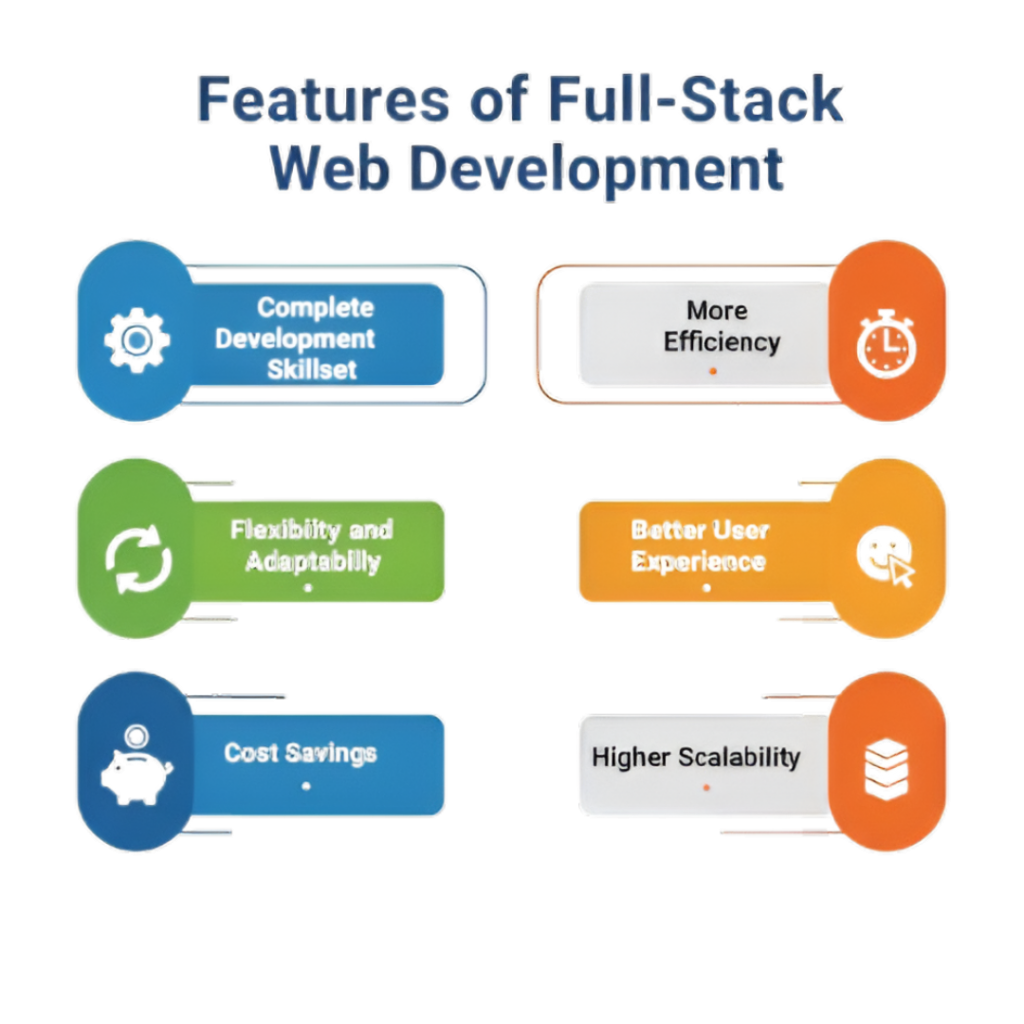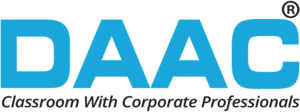Full Stack Web Development: A Step-by-Step Beginners Guide
Full Stack Development October 24, 2025

Introduction of Full Stack Web Development
Full stack web development encompasses all the tasks of planning, designing, and developing both the front-end and the back-end of a website or web application. The front end is what a user sees and interacts with, whereas the back end represents all of the data, server logic, and the database, or persistence layer, that the user does not see in use at the same time. A full-stack developer has the ability to handle all of the layers of development that include user interfaces, APIs, databases, and deployment. In the world of web development today, full-stack development is one of the most sought-after skills, as it allows those developers to build and maintain complete, dynamic, and efficient web solutions independently, without having to coordinate with multiple development teams. Overall, full-stack development is a highly desirable skill to have as a developer.Key Takeaway
- Full stack web development enables you to oversee both front-end and back-end responsibilities, making you a true web developer.
- There is a growing global need for full stack developers in many areas.
- By studying basic HTML, CSS, JavaScript, Node.js, and Python concepts, you can build a heavy foundation of technical skills.
- You will offer yourself long-term career development by continually learning new tools, frameworks, and trends.
- AI, cloud computing, and automation are emerging technologies that are shaping the future of full-stack development.
- So, full-stack development shows you career opportunities and a way out of the grind to the marketplace into an accepted role of innovation or independence.
Market Analysis of Full Stack Web Development
- The worldwide market for full-stack web development is rapidly increasing because of the subsequent demand for cohesive end-to-end digital solutions.
- The continued shift towards investing in rich front-end and back-end integration is resulting in the burgeoning development of seamless user experiences.
- The pace of innovation and adoption of increased cloud technologies, AI, and automation is resulting in the increased demand for professionals learning full-stack development.
- Start-ups and enterprises are looking for full-stack developers who can take control of the many layers of development as efficiently as possible.
- The full-stack developer market is expected to continue to follow a steady growth forecast into and through 2030 as a result of innovation and continued transformations in the digital space.
- Those working with both front- and back-end integration are at an advantage in the global job market.
Features of Full Stack Web Development
- Complete Development Skillset: Full-stack development encompasses both the front-end and back-end, providing developers the ability to create complete web solutions.
- Flexibility and Adaptability: A full-stack developer is able to use multiple technologies, tools, and databases, offering flexibility across various projects.
- More Efficiency: Because the individual developer handles both sides, they can easily coordinate feedback, and no dependency is created for two teams.
- Cost Savings: Businesses can hire one developer to cover the entire project; otherwise, they would associate each level with a different developer.
- Better User Experience: The front-end interface and back-end logic working seamlessly together provide a better overall user experience.
- Higher Scalability: As a full-stack web application matures, it will be easier to scale and upgrade with technology.
- Consistent Learning: When developers learn full-stack development, they are most likely exposed to new technologies, such as AIs, APIs, cloud computing, etc., and can maintain currency with evolving trends.

Step-by-Step Guide: How to Become a Full Stack Developer
Step 1: Understand the Fundamentals:
Learn the fundamentals of HTML, CSS, and JavaScript to develop web pages and get a sense of the interaction between front-end and back-end work. This is your foundation in full-stack development.Step 2: Master Front-End Development
Learn front-end frameworks (e.g., React, Angular, or Vue.js) to create dynamic, responsive, and user-friendly user interfaces. Learn design principles as well as how to put together responsive layouts and have a good understanding of version control tools (e.g., Git).Step 3: Master Back-End Development
Learn server-side programming languages (e.g. Node.js, Python, Java, PHP) in conjunction with a database (e.g., MySQL or MongoDB). Work on server logic, authentication, and database connectivity/integration.Step 4: Integrate Front-End and Back-End:
Particular attention and practice in learning to connect your front-end work with back-end services (API/RESTful endpoints) is key. A solid understanding of it is critical for a full-stack developer and integration should be a big part of your finish project that shows both front-end and back-endStep 5: Build Projects, Deploy, and Then Develop Your Career.
Complete real-life projects, for instance: a portfolio, an e-commerce application, or a blogging platform. Once done, you will need to know deployment products (e.g., AWS, Heroku, Netlify, ...) , put a portfolio together, and—even better (and what you absolutely must do)—continue to learn full-stack development. New programs or frameworks or tools will always be worthy of your attention.How to Develop a Career in Front-End and Back-End Integration.
1. Develop a Solid Foundation: Begin with learning core technologies such as HTML, CSS, and JavaScript alongside a front-end framework such as React or Angular. As you do this, familiarize yourself with backendlanguages such as Node.js, Python, or Java and databases such as MySQL or MongoDB. 2. Learn Integration Skills: Understand how to connect the front-end with back-end applications using APIs, RESTful services, and server-side programming. Data flow, authentication, and error handling are all important areas to know well when integrating back-end and front-ends together. 3. Create Real World Projects: Build real-world projects, including e-commerce, dashboards, or social media that need more than just simple front-end coding skills to show employers that you are capable of building application functionality between the front end and back end.- Pursue a Certification or Incure Professional Development: Finally, attend developer training programs to understand full-stack development and/or cloud development. Since this field is constantly changing and evolving, it is important to learn new frameworks, libraries, and tools to stay competitive in the job market.
- Network and Get Experience: Participate in and communicate with other developers on GitHub, Stack Overflow, and LinkedIn. Contribute to open-source coding and take internships or freelance jobs to gain real experience. Experience and networking are helpful in getting ahead in a full-stack integration role.
Challenges in Full Stack Website Development
- Keeping Up with Rapid Changes in Technology: Full-stack developers must stay updated with evolving front-end frameworks, back-end languages, and database technologies.
- Managing Front-End and Back-End Integration: Ensuring seamless communication between user interfaces and server logic can be complex, especially for large applications.
- Handling Security and Data Protection: Developers need to make sure secure authentication methods are implemented, protect sensitive data, and prevent vulnerabilities, such as SQL injection or cross-site scripting.
- Performance and Scalability Issues: Web applications must be responsive, fast, and scale well; this requires detailed planning, monitoring, testing, and validation.
- Debugging and Troubleshooting: finding and correcting areas and times when technology or frameworks break down can be time-consuming and technically challenging
- Balancing Multiple Responsibilities: Full-stack developers handle both designing user interfaces and controlling server-side logic—this can be overwhelming for beginners and new developers.
- AI-Driven Development: Artificial Intelligence is altering full-stack development by automating repetitive coding processes, optimizing workflows, and developing smarter user experiences via chatbots, recommendation engines, or predictive analysis.
- AI and Cloud Services Integration: The combination of AI and cloud service integrates real-time data processing, intelligent automation and/or scalable machine learning capabilities within a full stack application.
- Cloud-Based Applications: Platforms like AWS, Azure, and Google Cloud enable developers to deploy, scale and manage applications in a more efficient manner. Increased cloud integration for full stack developers can now handle storage, hosting, and serverless architectures.
- Improved Collaboration and Develop: Cloud-based DevOps tools simplify the integration of front-end and back-end development, CI/CD or collaborative development, making full stack development faster and efficient.
- Future Focused on Scalability and Security: Future full stack applications will focus on secured cloud deployments, encrypted data managements, and AI-based monitoring for performance, reliability, and safety.
- Upskilling for the Future: Developers that are for learning full stack development while learning AI and read world cloud technologies will always be a top contender in the growing space. There will be advanced and/or newer career opportunities with this additional skill set.

